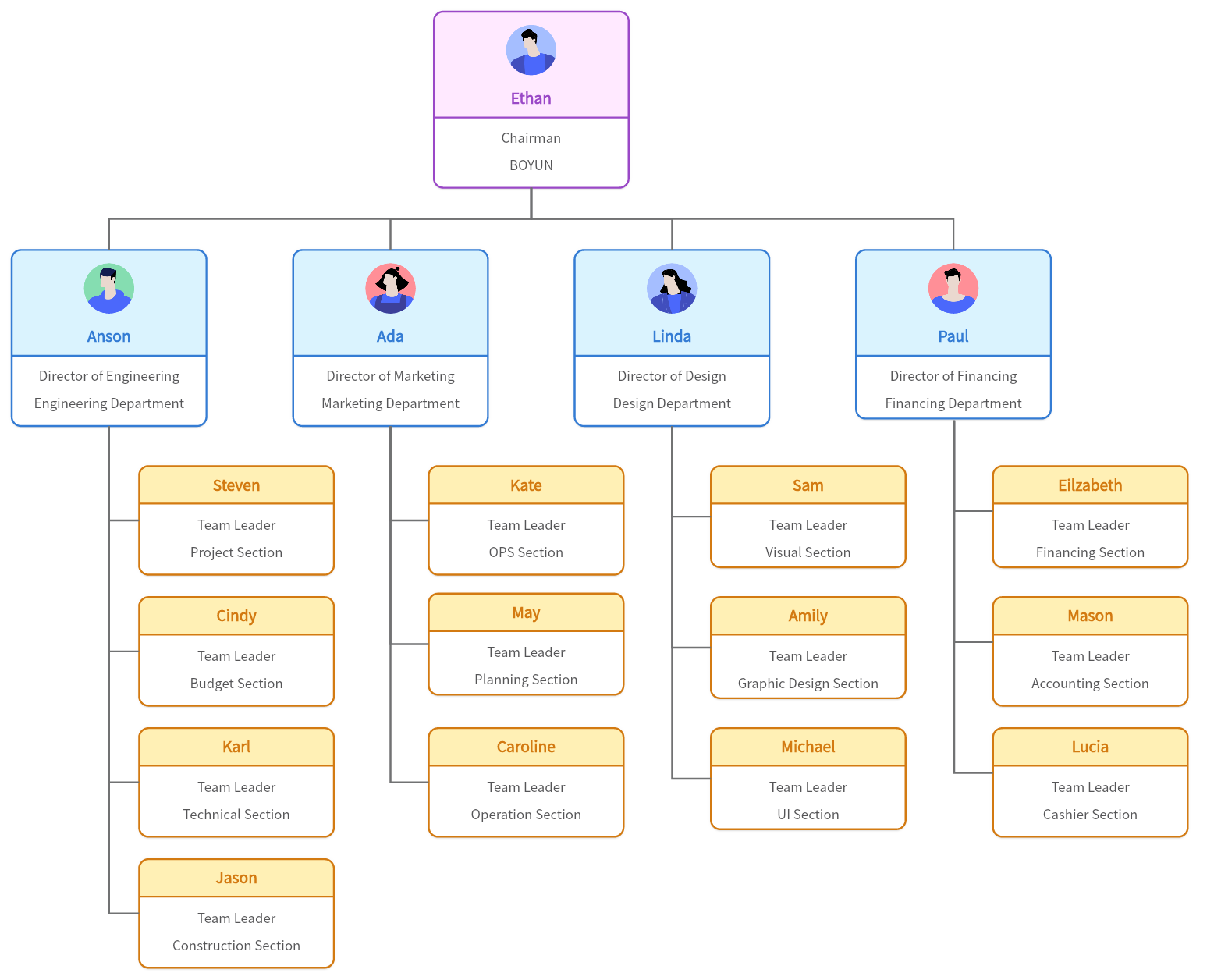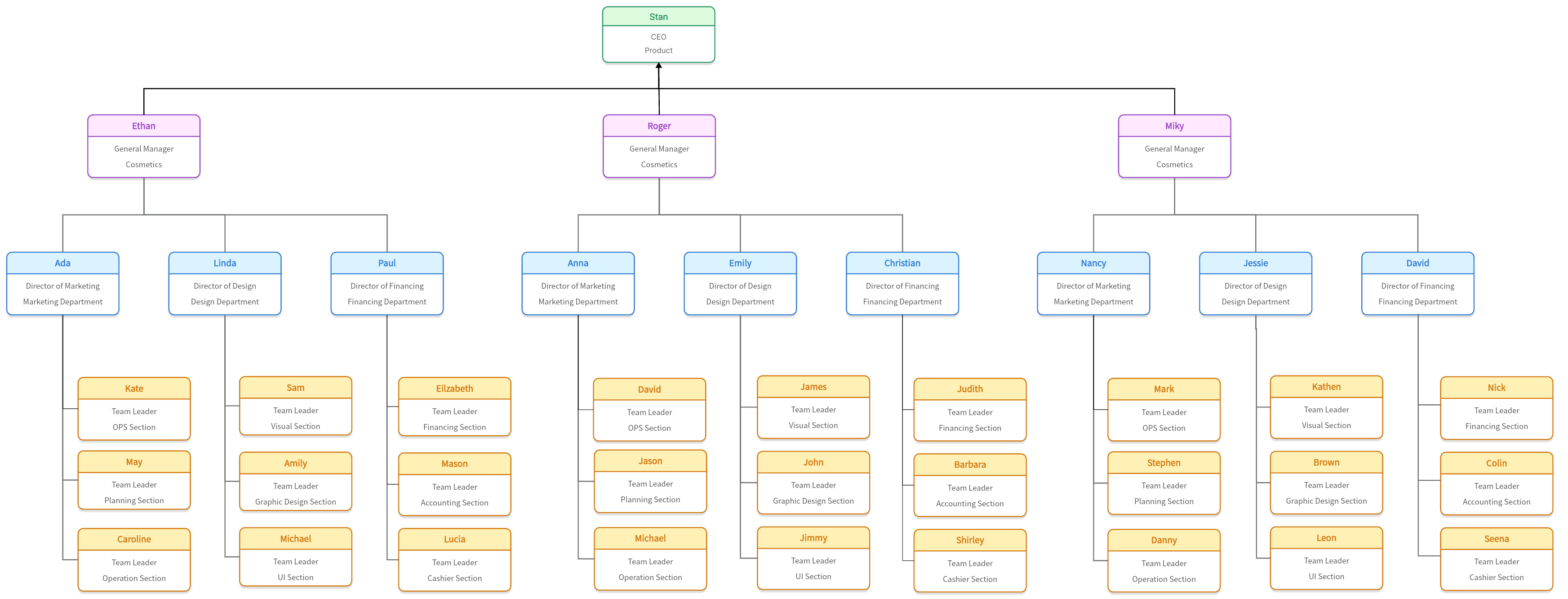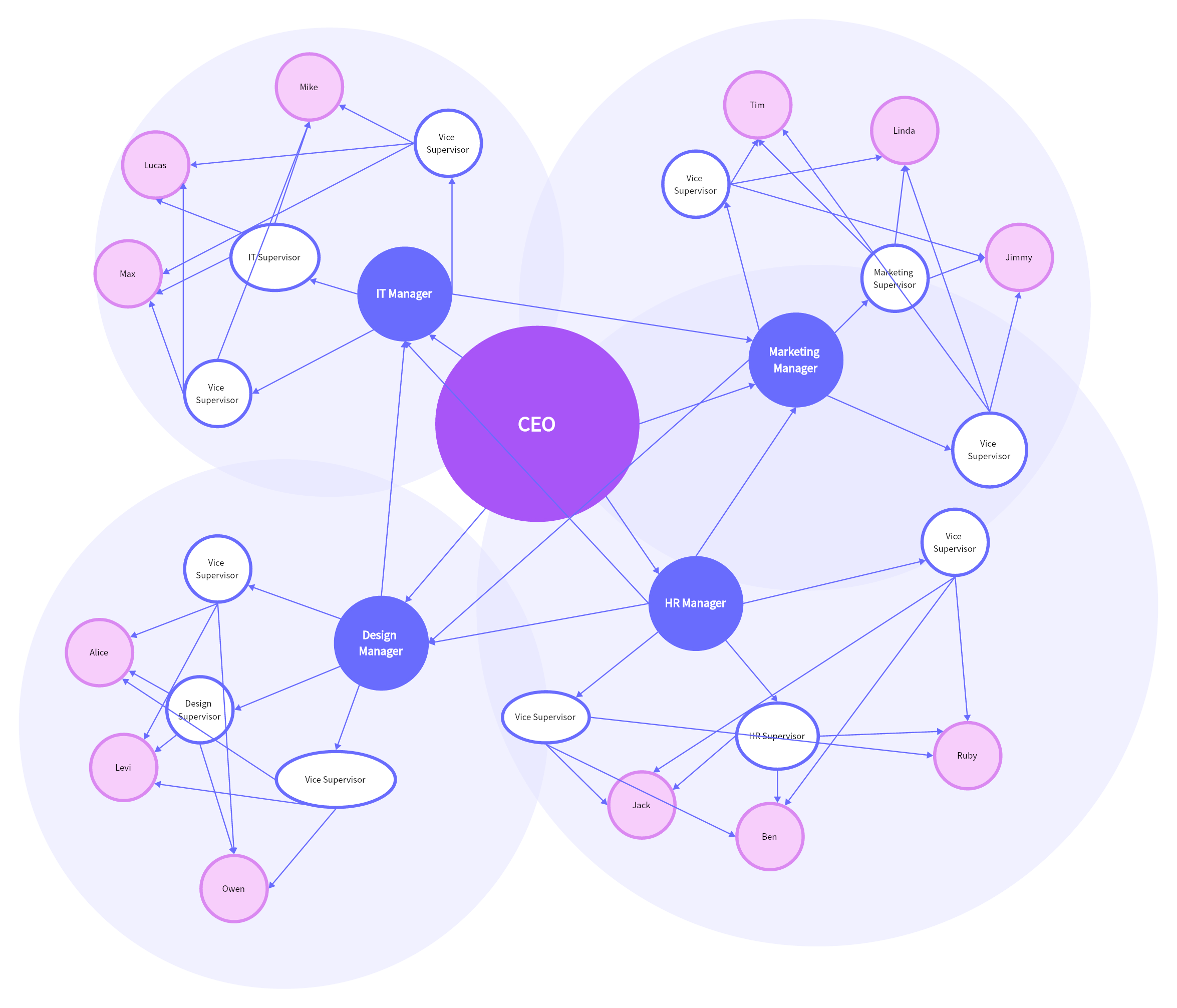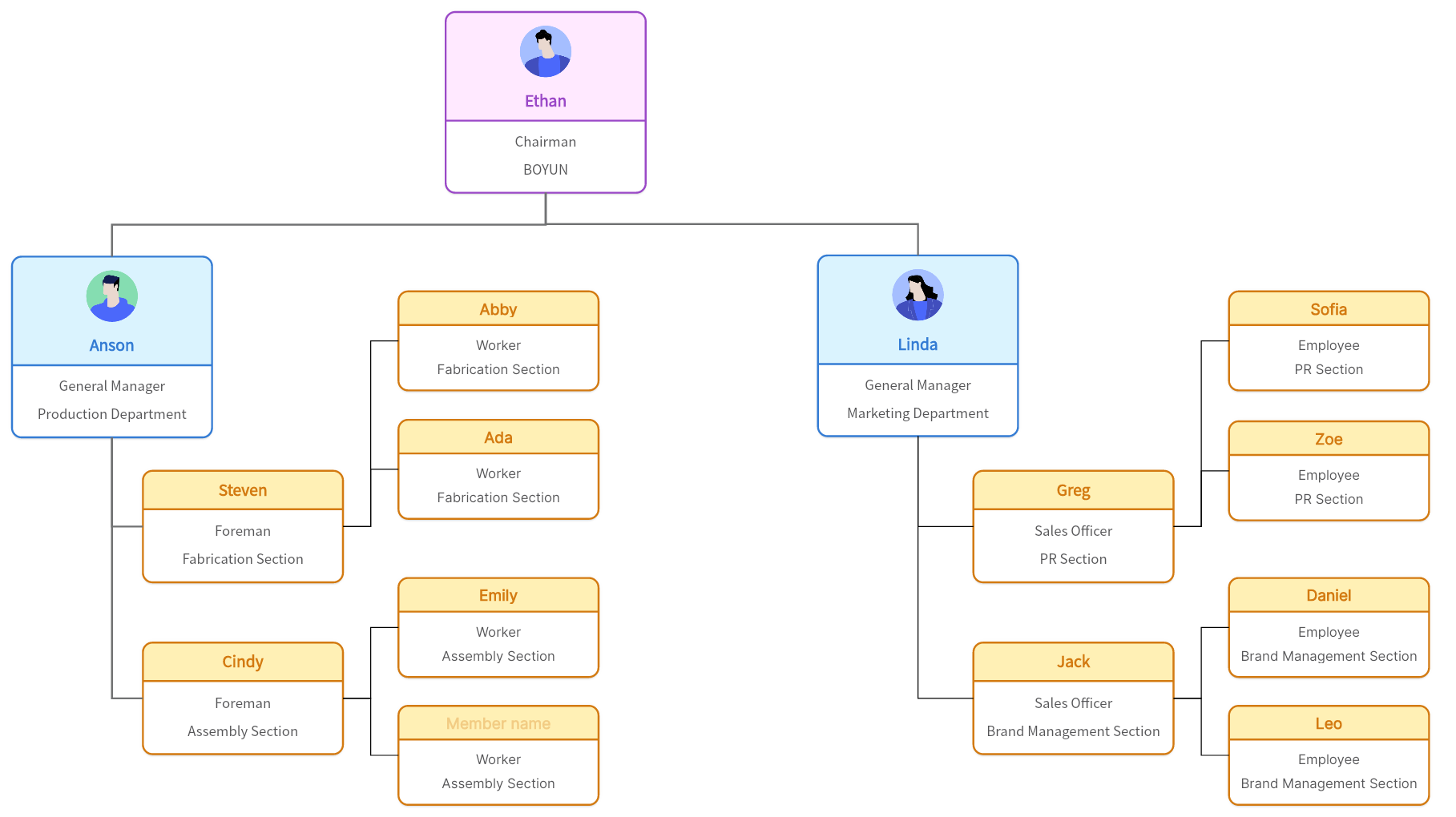An organizational structure is essential for businesses with multiple employees, even in small companies. Exploring various types of organizational structures commonly used in businesses, we'll provide examples for each kind. Understanding their features and benefits will help you determine the best fit for your business, ensuring effective management and optimized operations.
What is an organizational structure?
The organizational structure outlines employee responsibilities, superiors, and subordinates, defining their roles within the organization. Various types of structures exist, visually represented through organizational charts displayed in the workplace and on the company's website. These charts offer a clear overview of the company's hierarchy and facilitate effective communication and collaboration among team members.
Different types of organizational structures
Organizational structures can be classified as either centralized or decentralized. The majority of businesses follow the traditional centralized structure, with an individual or group at the helm, and where a chain of command exists, connecting all members of the organization.
While this remains to be the more popular organizational structure example, a lot of companies are now adapting the more contemporary decentralized model. This structure gives teams broader decision-making capacity and allows for more collaboration, which is ultimately great for business adaptability and versatility. But aside from these two major types, several other types of organizational structures are being used.
Hierarchical structure
Most large companies and organizations today follow a hierarchical structure, which is quite a straightforward configuration with well-defined roles and relationships between the entities. Typically shaped like a pyramid, the hierarchical structure positions the leader at the top, with the board of directors holding the most influential role in the company's decision-making process. This clear hierarchy ensures effective governance and efficient delegation of responsibilities, empowering each level to contribute to the organization's success.Then comes the next level of leadership on the second level, which would be the CEO. The next level would be taken by the CFO, the COO and the vice presidents, and their subordinates would be in the next level, and so on.
This very simple structure is excellent for establishing the chain of command, as well as promoting unity among the departments, as they are grouped together. Opportunities for promotion are also theoretically easy to grab as everyone can see the next rung on the corporate ladder from where they are currently situated. However, it is a rather rigid structure so innovation and adaptability might not be very easily done. Collaboration across different departments is not always accessible as well.

Functional structure
The functional structure, as the name suggests, groups employees according to the function that they perform. Many org chart examples that follow this structure would have the marketing department in one area of the chart, the sales department in another area, the legal department in yet another, and so on.
A functional structure works best for defining the roles of employees, monitoring their work performance, and providing opportunities for skill growth. Additionally, an organized structure allows easy identification of departments to address specific issues. However, it may lead to departmental isolation and hinder cross-collaboration within the company. Each group might just be focused on what they are doing without having any awareness of the overall progress of a project, and this might cause problems for the business.

Matrix structure
Quite different from traditional organizations, the matrix structure has employees reporting to multiple supervisors. In an organizational chart example, an employee tasked to create ads for a product might have to report to the advertising manager, as well as the product manager.
It might seem confusing, especially to those used to a more straightforward model, but the matrix structure is great for establishing a flexible work setup, which is a priority for many forward-thinking companies these days. It also promotes sharing of resources between different areas of the business, which can reduce overall expenses. However, the matrix structure also brings about multiple challenges in accounting for resources, as well as monitoring budgets.

Flat structure
Also known as the horizontal structure, the flat structure is most easily distinguished by the absence of middle management. It is most frequently used by smaller companies since they don’t have much middle management anyway, if at all. In a flat structure, the upper management is still on top but the lower-level staff have more power in making decisions, and are typically assigned more roles.
Without an extensive chain of command and therefore fewer delays, the flat structure allows businesses to accomplish more in less time and at a lower cost. There is also often a closer professional relationship within the business. There are cases where this can be a drawback too, like when there is a need for conflict resolution or when the decision-making responsibilities tend to overlap.

Divisional structure
In a very large company that has multiple products or operates in different physical locations, the divisional structure makes a lot of sense. In this organizational chart example, the company is divided into geographic areas, product types, and so on. Breaking down the company in this way makes for easier management and better productivity across the board.
The mentioned organizational structure empowers divisions to focus on their work and make independent decisions, enhancing productivity. Addressing specific needs without external interference boosts efficiency. However, this isolation may lead to duplication of work that could be shared among divisions. Additionally, decentralization of decision-making can pose long-term challenges as each division prioritizes its concerns independently. Balancing autonomy and collaboration is crucial for optimizing outcomes and fostering a cohesive organizational culture. Centralizing certain decision-making aspects can ensure alignment with broader company objectives while preserving the benefits of divisional autonomy.

Network structure
The network structure is a suitable option for businesses that outsource services or products to other businesses, or that have partnerships with several clients, suppliers, distributors, investors, and so on. In contrast to the typical org chart examples that deal more with hierarchy, the network structure focuses on relationships with other entities, both internal and external.
The biggest benefit of adapting a network structure is that the core company can focus on what they do best, while significantly reducing costs at the same time. However, the high flexibility of this kind of structure can create confusion since there is no longer a clear definition of roles.

Team-based structure
This project-based organizational structure divides the organization into teams assigned to specific projects. These teams are not permanent and may disband after project completion or be reassigned to new tasks. Employees frequently transition between teams as they are assigned to different projects. This dynamic structure fosters adaptability, allowing the organization to efficiently allocate resources based on project demands while promoting cross-functional collaboration and diverse skill development among team members.
Because of this, a team-based structure is very fluid and helps a lot with productivity since employees with similar skills and experience can work together. It also builds camaraderie among employees as they get a chance to work with different groups. However, as you would also expect from a highly flexible setup, the team-based structure doesn’t provide much consistency nor contact with other teams while the project is ongoing.

Line structure
Similar to the hierarchical structure, the line structure follows a top-down chain of command. However, it is simpler, with no multiple departments involved, allowing decisions to be made without the need for extensive conferencing. This straightforward approach streamlines decision-making and fosters efficiency, making it ideal for smaller organizations with less complex operational requirements.
This structure offers fast decision-making, clear authority lines, and stability. However, its rigidity limits adaptability. The general manager's absolute authority may not be ideal in some situations. Finding a balance between streamlined operations and flexibility is crucial for optimizing organizational performance and fostering a dynamic work environment.

FAQs of organizational structures
What is the most common organizational structure?
Most businesses adopt a traditional hierarchical structure in their organizational chart. The board of directors occupies the top position, followed by the CEO, managers, and regular staff in a downward progression of authority. This clear chain of command facilitates effective decision-making and enables efficient communication and coordination throughout the organization.
What is the difference between an organizational structure and an organizational chart?
An organizational structure is a foundational framework that delineates the roles and responsibilities of each member within a company or organization. On the other hand, an organizational chart serves as a visual representation of this hierarchical structure, offering a clear overview of the company's internal hierarchy and reporting relationships.
What is the best type of organizational structure to use?
There is no single best type of organizational structure for every business. To determine the best for your organization, review the different types available, consider your company's size, goals, and setup, then create an org chart of the structures you are considering. This should be able to help you figure out which particular structure would work best for your business.













